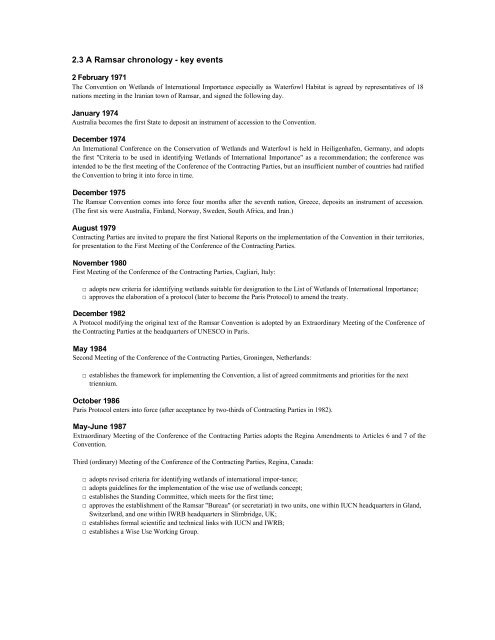The Ramsar Convention Manual.pdf
The Ramsar Convention Manual.pdf
The Ramsar Convention Manual.pdf
Create successful ePaper yourself
Turn your PDF publications into a flip-book with our unique Google optimized e-Paper software.
2.3 A <strong>Ramsar</strong> chronology - key events<br />
2 February 1971<br />
<strong>The</strong> <strong>Convention</strong> on Wetlands of International Importance especially as Waterfowl Habitat is agreed by representatives of 18<br />
nations meeting in the Iranian town of <strong>Ramsar</strong>, and signed the following day.<br />
January 1974<br />
Australia becomes the first State to deposit an instrument of accession to the <strong>Convention</strong>.<br />
December 1974<br />
An International Conference on the Conservation of Wetlands and Waterfowl is held in Heiligenhafen, Germany, and adopts<br />
the first "Criteria to be used in identifying Wetlands of International Importance" as a recommendation; the conference was<br />
intended to be the first meeting of the Conference of the Contracting Parties, but an insufficient number of countries had ratified<br />
the <strong>Convention</strong> to bring it into force in time.<br />
December 1975<br />
<strong>The</strong> <strong>Ramsar</strong> <strong>Convention</strong> comes into force four months after the seventh nation, Greece, deposits an instrument of accession.<br />
(<strong>The</strong> first six were Australia, Finland, Norway, Sweden, South Africa, and Iran.)<br />
August 1979<br />
Contracting Parties are invited to prepare the first National Reports on the implementation of the <strong>Convention</strong> in their territories,<br />
for presentation to the First Meeting of the Conference of the Contracting Parties.<br />
November 1980<br />
First Meeting of the Conference of the Contracting Parties, Cagliari, Italy:<br />
□ adopts new criteria for identifying wetlands suitable for designation to the List of Wetlands of International Importance;<br />
□ approves the elaboration of a protocol (later to become the Paris Protocol) to amend the treaty.<br />
December 1982<br />
A Protocol modifying the original text of the <strong>Ramsar</strong> <strong>Convention</strong> is adopted by an Extraordinary Meeting of the Conference of<br />
the Contracting Parties at the headquarters of UNESCO in Paris.<br />
May 1984<br />
Second Meeting of the Conference of the Contracting Parties, Groningen, Netherlands:<br />
□ establishes the framework for implementing the <strong>Convention</strong>, a list of agreed commitments and priorities for the next<br />
triennium.<br />
October 1986<br />
Paris Protocol enters into force (after acceptance by two-thirds of Contracting Parties in 1982).<br />
May-June 1987<br />
Extraordinary Meeting of the Conference of the Contracting Parties adopts the Regina Amendments to Articles 6 and 7 of the<br />
<strong>Convention</strong>.<br />
Third (ordinary) Meeting of the Conference of the Contracting Parties, Regina, Canada:<br />
□ adopts revised criteria for identifying wetlands of international impor-tance;<br />
□ adopts guidelines for the implementation of the wise use of wetlands concept;<br />
□ establishes the Standing Committee, which meets for the first time;<br />
□ approves the establishment of the <strong>Ramsar</strong> "Bureau" (or secretariat) in two units, one within IUCN headquarters in Gland,<br />
Switzerland, and one within IWRB headquarters in Slimbridge, UK;<br />
□ establishes formal scientific and technical links with IUCN and IWRB;<br />
□ establishes a Wise Use Working Group.












